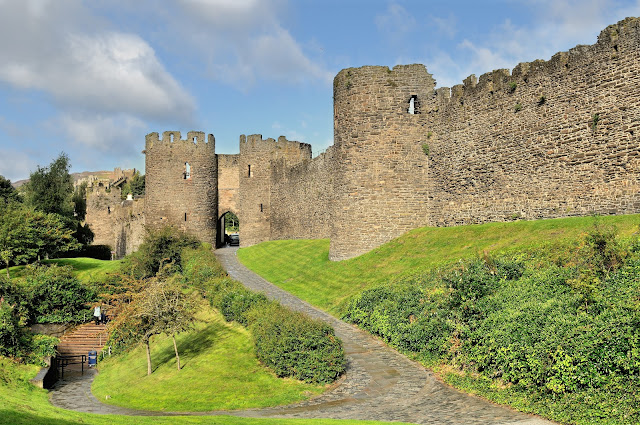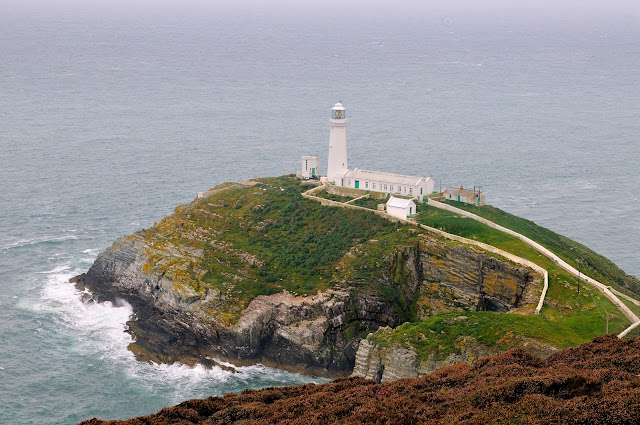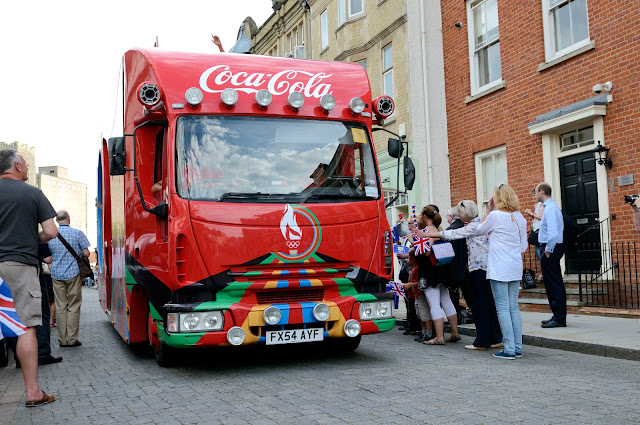One of the first places we visited was South Stack Lighthouse, built on a small island off the north-west coast of Holyhead, Anglesey, Wales. It was built in 1809 to warn ships of the dangerous rocks below.
Some history of Anglesey:
Historically, Anglesey has long been associated with the druids. In AD 60 the Roman general Gaius Suetonius Paulinus, determined to break the power of the druids, attacked the island using his amphibious Batavian contingent as a surprise vanguard assault and then destroying the shrine and the nemetons (sacred groves). News of Boudica's revolt reached him just after his victory, causing him to withdraw his army before consolidating his conquest. The island was finally brought into the Roman Empire by Gnaeus Julius Agricola, the Roman governor of Britain, in AD 78. During the Roman occupation, the area was notable for the mining of copper.
British Iron Age and Roman sites have been excavated and coins and ornaments discovered, especially by the 19th century antiquarian, William Owen Stanley. Following the Roman departure from Britain in the early 5th century, pirates from Ireland colonised Anglesey and the nearby Llŷn Peninsula. In response to this, Cunedda ap Edern, a Gododdin warlord from Scotland, came to the area and began to drive the Irish out. This was continued by his son Einion Yrth ap Cunedda and grandson Cadwallon Lawhir ap Einion; the last Irish invaders were finally defeated in battle in 470.
As an island, Anglesey was in a good defensive position, and so Aberffraw became the site of the court, or Llys, of the Kingdom of Gwynedd. Apart from a devastating Danish raid in 853 it remained the capital until the 13th century, when improvements to the English navy made the location indefensible. Anglesey was also briefly the most southern possession of the Norwegian Empire.
After the Irish, the island was invaded by Vikings and by Saxons, and Normans, before falling to Edward I of England in the 13th century.
At the start of our stay we were treated to this stunning sunset.
However, the daytime scenes were also beautiful.
Barclodiad y Gawres (Welsh for 'apronful of the giantess') is a Neolithic burial chamber between Rhosneigr and Aberffraw on the southern coast of the island of Anglesey in North Wales. It is an example of a cruciform passage grave, a notable feature being its decorated stones. Similar graves and marks exist across the Irish Sea in the Boyne Valley.
Full excavations were performed in 1952–53, after which the chamber was re-roofed with concrete and covered with turf to resemble the original structure. During the excavations two cremated young male burials were found within the south-western side-chamber. The central area of the main chamber contained the remains of a fire on which had been poured a stew including wrasse, eel, frog, toad, grass-snake, mouse, shrew and hare, then covered with limpet shells and pebbles.
Then on to our next adventure Llanddwyn Island (Ynys Llanddwyn) which is a magical place. Located at the far end of a pleasant beach near Newborough Warren (above), this narrow finger of land is an ideal picnic site during fine weather, but also an exhilarating place when the winter winds blow. Its rolling dunes, large rock outcrops and mixture of historic buildings makes it an ideal place for an afternoon of exploration.
Llanddwyn is not quite an island. It remains attached to the mainland at all but the highest tides. It provides excellent views of Snowdonia and the Lleyn Peninsula and is part of the Newborough Warren National Nature Reserve.
The magical story of Llanddwyn Island (Ynys Llanddwyn)
The name Llanddwyn means "The church of St. Dwynwen". She is the Welsh patron saint of lovers, making her the Welsh equivalent of St. Valentine. Her feast day, 25 January, is often celebrated by the Welsh with cards and flowers, just as is 14 February for St. Valentine.
Dwynwen lived during the 5th century AD and was one of 24 daughters of St. Brychan, a Welsh prince of Brycheiniog (Brecon). She fell in love with a young man named Maelon, but rejected his advances. This, depending on which story you read, was either because she wished to remain chaste and become a nun or because her father wished her to marry another. She prayed to be released from the unhappy love and dreamed that she was given a potion to do this. However, the potion turned Maelon to ice. She then prayed that she be granted three wishes: 1) that Maelon be revived, 2) that all true lovers find happiness, and 3) that she should never again wish to be married. She then retreated to the solitude of Llanddwyn Island to follow the life of a hermit.
Dwynwen became known as the patron saint of lovers and pilgrimages were made to her holy well on the island. It was said that the faithfulness of a lover could be divined through the movements of some eels that lived in the well. This was done by the woman first scattering breadcrumbs on the surface, then laying her handkerchief on the surface. If the eel disturbed it then her lover would be faithful.
Visitors would leave offerings at her shrine, and so popular was this place of pilgrimage that it became the richest in the area during Tudor times. This funded a substantial chapel that was built in the 16th century on the site of Dwynwen's original chapel. The ruins of this can still be seen today.
The Celtic cross, erected at the end of the 19th Century, is a form of Christian cross featuring a nimbus or ring that emerged in Ireland and Britain in the Early Middle Ages. The poignant inscriptions on the cross reads: “they lie around did living tread, this sacred ground now silent – dead“. In English on one side, and Welsh on another. Apparently F G Wynn erected this cross to commemorate Llanddwyn Church, which at that time was largely ruined and overgrown.
As well as its mystical associations with Dwynwen, Llanddwyn was, until fairly recent times, important for its lifeboats and for the pilots that helped guide ships into the Menai Strait.
The small cannon that stands outside the cottages was used to summon the lifeboat crew (way before mobile phones and beepers).
Tŵr Mawr lighthouse (meaning "great tower" in Welsh), on Ynys Llanddwyn on Anglesey, Wales, marks the western entrance to the Menai Strait. The 1873 tower is tapered in a style characteristic of Anglesey windmills. It is 33 feet (10 m) high and 18 feet (5.5 m) in diameter. It may have been constructed by an Anglesey stone mason, and it is possible that the tower itself was originally used as a windmill.
The lantern and fittings cost £250 7s 6d, including the adaptation of an "earlier tower". The north-east door is flanked by small windows, and the two floors above also have small windows, but the top does not. The conical roof is slated and has a flagpole. The present lantern window is about 6 feet 6 inches (1.98 m) by 2 feet (0.61 m). The optic, silver-plated reflector and Fresnel lens are dated 1861 and were used into the 1970s. The lantern was originally lit by six Argand lamps with reflectors.
A smaller, conical tower, with a domed top, can be found to the south-east, and may be an earlier structure. The walls are 6 feet 8 inches (2.03 m) in radius and 3 feet (0.91 m) thick, with a door to the north-west, and show signs of cracking to the rubble-filled walls on the west.
Neither tower is shown on the chart of Lewis Morris, dated 1800, but they both appear on the Ordnance Survey 1818-1823 2 inches/mile map. They both probably originated as unlit markers. The cottages nearby have been used as craft workshops, and the local community here once serviced pilot-boats and lifeboats.
The inscriptions on the plain cross, one on each side, read: “Dwynwen“; “in the sixtieth year of Queen Victoria 1897“; “in memory of St Dwynwen Jan 25th 1465“; and, “erected by the Hon F G Wynn owner of the isle“. And that was at the start of 20 Century.
Known as the Heritage Gate on Llanddwyn Island. The island as a whole is definitely a magical place and we had a great day here.






















































